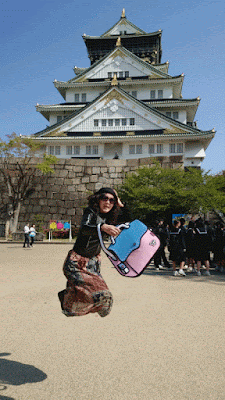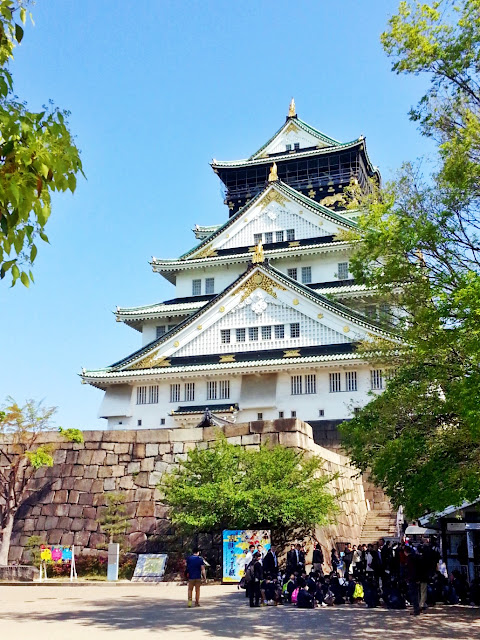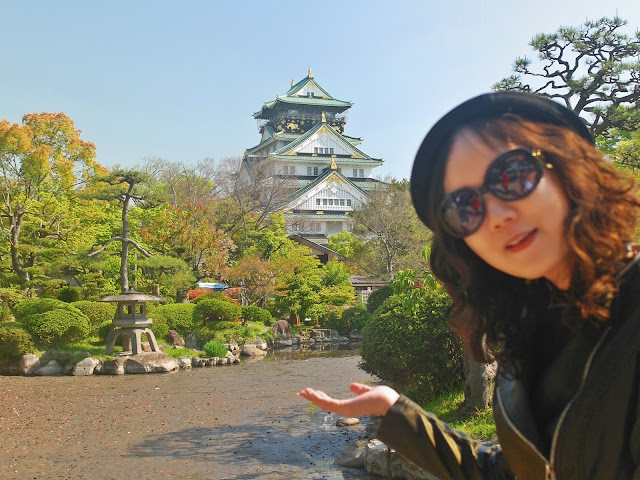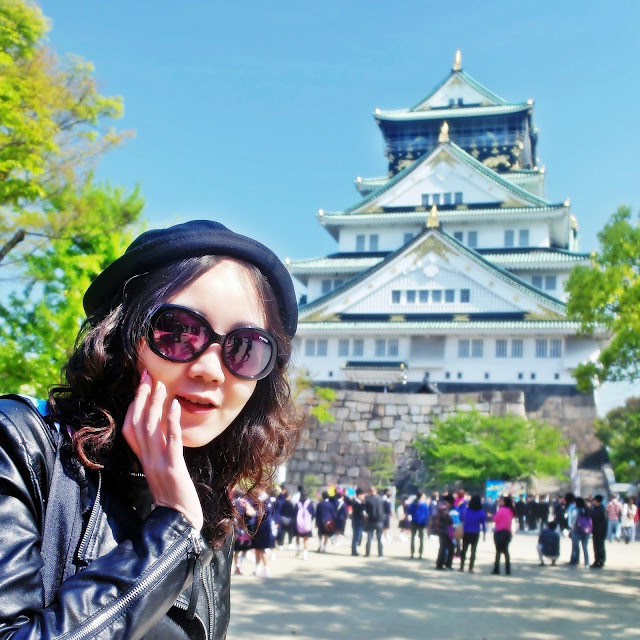Remember the earlier post about Kaiseki “Taiko-en,” Restaurant? It was named after Hideyoshi Toyotomi (widely known as Taiko) who built Osaka Castle.
This 500 years Osaka Castle (大坂城 ) played a major role in the unification of Japan during the sixteenth century of the Azuchi-Momoyama period.
The most grandiose and famous historical architecture in Osaka.


Let's start the journey from Sakura-mon (Cherry Gate).
The gate built using cherry trees planted near the gate during Toyotomi period.
It's the main Gate of Homaru (Inner Baily) of Osaka Castle.

 Originally built during Edo Period in 1626, then it was burnt down
Originally built during Edo Period in 1626, then it was burnt down
by fire during the Meiji Restoration in 1868. It was rebuilt by
the Imperial Army in 1887.
Sakuramon is important Cultural Property of Japan.

Playing hide and seek with Osaka Castle behind this stunning stone wall,
while we're standing beside Sakuramon as our guide told us the
history and interesting facts about Osaka Castle.


Our tour was not including admission inside the castle.

Let's start the journey from Sakura-mon (Cherry Gate).
The gate built using cherry trees planted near the gate during Toyotomi period.


by fire during the Meiji Restoration in 1868. It was rebuilt by
the Imperial Army in 1887.
Sakuramon is important Cultural Property of Japan.

Playing hide and seek with Osaka Castle behind this stunning stone wall,
while we're standing beside Sakuramon as our guide told us the
history and interesting facts about Osaka Castle.

'Takoishi Stone' (Octopus Stone) is the most gigantic granite boulders in Osaka Castle
with a surface
area of 59.43 ㎡ and estimated weight of 108 tons.
Yes, I was totally stoned seeing Takoishi, it made me feel so tiny. No wonder our guide said enemies chickened out and felt defeated when they faced this enormous stone.
Legend has it that powerful Daimyo from all parts of Japan competed
in carrying these large boulders to show their loyalty to the Toyotomi.
These boulders were brought from rock quarries near the Seto Inland Sea,
and bear inscribed crests of the various families who contributed them.

The third largest stone next to Takoishi Stone called 'Furisodeishi',
meaning long-sleeved kimono stone.
Yes! I found a big treasure~!!!
This Time Capsule was made
during the 1970 EXPO and buried at Osaka Castle ground. It contained 2098 objects and recorded items representing the achievements of our civilization and the everyday experience of the Japanese people of the 20th century. It'll be opened in year 6970 which is 5000 years later. Curious on what items concealed inside this capsule? Click this link for the contents and more information.
Osaka Castle contains thirteen structures.
Japanese Government designated the main Osaka Castle tower
as a Registered Tangible Cultural Property in 1997.
It all started half a millennium ago...
Priest Rennyo of
the huge Honganji Temple built monks' quarters in 1496.


37 years later... these quarters became a
temple in their own right.
The name "Osaka" first appears in a written history of this Ishiyama
Honganji.
Grandeur Osaka Castle in pure white and striking accents of glittery gold.
In 1583, Hideyoshi began construction at the former site of Honganji Temple, and completed the magnificent and unrivaled castle in the country.
He was absolutely fascinated with gold. Not only applied see gold leaf on the sides of the Main Tower of Osaka Castle. He also constructed of a golden tea room with walls,
pillars, ceiling, including tea utensils were finished with
gold.
Osaka Castle is widely known as an emblem of the power and fortune of Hideyoshi Toyotomi.
Osaka Castle Japanese Garden Park.
Our guide told us this secret place which is less crowded,
but has splendid view of Osaka Castle and Japanese Garden.
Free admission to this lovely urban park at the ground of Osaka Castle.
Sorry... just couldn't help not to take photos :P

Opposite of the park, you can see few mobile food carts selling ice cream,
crepes, and snacks (check the above Youtube video).
In spring, 600 cherry trees at Osaka Castle's lawn garden is
popular for cherry blossom (hanami) and plum blossom viewing.

Auuwww~! colorful... cheerful... charming spring~!


Blue sky... Green fields decorated with pink flowers...


creating ultimate spring landscape at Osaka Castle.
Imperial Japanese Army facilities also located here.






This ended of our touring at Osaka Castle.
One of the charms of this castle is the beauty of its stone wall.
Reportedly, there are 500,000 to 1,000,000 rocks used for this
12 kilometers granites wall.
Dry moat in front of Sakuramon.
The moats are 70 to 90 meters in width and more than 20 meters
in height.
The castle tower is surrounded by magnificent moats and impressive stone walls,
secondary citadels, turrets and gates are symbols of solid defenses of Tokugawa.
Ichiban-yagura (Turret) standing between the raised land of
Southern Outer Moat and the Inner Moat.
It provided protection to the South Eastern side of Osaka Castle.

"Aqua-Liner""water bus service cruising around the castle waterways to
enjoy famous historical sites through the river that flows through Osaka.
Strolling outside Ume plum groove.
It has 95 kinds of Japanese apricot flowers.
Hey... these birds were parking nearby bus parking area!
Admission Fee: 600 yen
Castle Tower Opening Hours: 9:00 to 17:00 (entrance until 16:30)
Closed: December 28 to January 1





























No comments:
Post a Comment